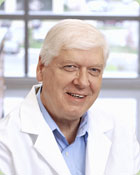
About
Biographies
Research Interests and Accomplishments
Hamilton O. Smith received an A.B. degree in mathematics at the University of California, Berkeley in 1952 and the M.D. degree from Johns Hopkins University in 1956. After six years of clinical work in medicine (1956-1962), he carried out research on Salmonella phage P22 lysogeny at the University of Michigan, Ann Arbor (1962-1967). In 1967, he joined the Microbiology Department at Johns Hopkins. In 1968, he discovered the first TypeII restriction enzyme (HindII) and determined the sequence of its cleavage site. In, 1978 he was a co-recipient (with D. Nathans and W. Arber) of the Nobel in Medicine for this discovery.
Subsequently, he studied DNA methylases and nucleases in Haemophilus influenzae Rd and discovered this organism's sequence-specific DNA uptake during genetic transformation. In 1994-5 he collaborated with J. Craig Venter at The Institute for Genomic Research (TIGR) to sequence H. influenzae by whole genome shotgun sequencing and assembly. In July 1998, he joined Celera Genomics Corporation where he participated in the sequencing of the Drosophila and human genomes. In November 2002, he left Celera to join the newly launched J. Craig Venter Institute where he is currently leading the synthetic biology and biological energy groups.
Publications
Gibson, D. G., Benders, G. A., et al.
Complete Chemical Synthesis, Assembly, and Cloning of a Mycoplasma genitalium Genome
Science. 2008 Jan 24; 319(5867): 1215-20.[more]
Lartigue, C., Glass, J. I., et al.
Genome Transplantation In Bacteria: Changing One Species to Another
Science. 2007 Aug 03; 317(5838): 632-8.[more]
Glass JI, Assad-Garcia N, et al.
Essential Genes of a Minimal Bacterium.
Proceedings of the National Academy of Sciences of the United States of America. 2006 Jan 10; 103(2): 425-30.[more]
Hutchison, C. A., 3rd, Smith, H. O., et al.
Cell-free Cloning Using Phi29 DNA Polymerase
Proc Natl Acad Sci U S A. 2005 Nov 29; 102(48): 17332-6.[more]
Smith, H. O., Hutchison, C. A., 3rd, et al.
Generating a Synthetic Genome by Whole Genome Assembly: PhiX174 Bacteriophage from Synthetic Oligonucleotides
Proc Natl Acad Sci U S A. 2003 Dec 23; 100(26): 15440-5.[more]
Venter, J. C., Smith, H. O., et al.
A New Strategy for Genome Sequencing
Nature. 1996 May 30; 381(6581): 364-6.[more]
Fraser, C. M., Gocayne, J. D., et al.
The Minimal Gene Complement of Mycoplasma genitalium
Science. 1995 Oct 20; 270(5235): 397-403.[more]
Fleischmann, R. D., Adams, M. D., et al.
Whole-genome Random Sequencing and Assembly of Haemophilus influenzae Rd
Science. 1995 Jul 28; 269(5223): 496-512.[more]
Fields, C., Adams, M. D., et al.
How Many Genes In the Human Genome?
Nat Genet. 1994 Jul 01; 7(3): 345-6.[more]

